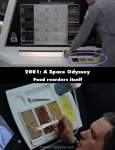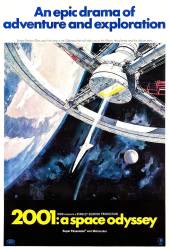Other mistake: There is something drastically wrong with the design of the spherical 'Aries' moon shuttle. Some seats and many fixtures are 'upside down' relative to the up-down orientation of the shuttle itself, and we see loose food trays and equipment about the place as if this is routine. But - the shuttle is designed to land on the moon. What happens then? The moon has gravity, remember? There are going to be quite a few very disgruntled people dangling upside down like spiders, and there will be loose gear (and perhaps a stewardess or two) bouncing about all over the place. It is not a matter of stowing loose gear or lying flat on landing - some parts of the shuttle are upside down relative to others, which is why the stewardess has to do that famous 180 degree upside down walk. Whichever way you look at it the shuttle is going to encounter serious problems when it reaches a gravity well, which will occur whenever the engines are fired up, never mind landing on the moon.
Revealing mistake: When we see the space station from the cockpit of the approaching shuttle, the station does not appear to rotate because the shuttle is rotating at the same speed. OK...except that the station IS still rotating with respect to the sun, which means that the light source and shadows on the station should be moving.

Continuity mistake: When Dave gets his supper, the order of the slop from right to left is yellow, light brown, light brown, dark brown. Later when he's eating, the order is yellow, orange brown, dark brown, light brown. (00:59:00 - 00:59:50)
Continuity mistake: The view of the front of the moon buggy shows the sunlight coming from the right side of the screen(Pilot's left shoulder) But when we see his view out the window, the sunlight casts shadows as if the sun was behind them.
Revealing mistake: During the "Dawn of Man" sequence, the ape-man scenes were shot on an indoor stage with projected background images on a huge screen behind the stage. The screen itself was a highly reflective cloth. In most shots, it is quite convincing, but in several (especially when facing the aggressive, victorious group during the first fight, then again when facing the tool-using group in the last fight), the rear screen appears to be a patchwork of smaller pieces of cloth as very obvious puzzle-like shapes of varying reflectivity appear in the sky. Once you notice them, it's incredibly distracting. It was originally parallel strips, but they were VERY visible as vertical lines so they were torn into a patchwork to make lines less obvious. (00:08:35 - 00:18:00)
Continuity mistake: Several times during Heywood's speech to the team at the moon base, his arms shift from his sides with hands in pockets to in front of him with hands on the podium.
Continuity mistake: The formation of the astronauts on the ramp to TMA-1 shifts from shot to shot.
Revealing mistake: When the astronauts are on the way to the monolith on the Moon, there are two windows seen within the interior of the small space shuttle. During their small lunch, in the left window, the horizon is seen as the surface of the Moon is flowing back against the direction of the flight. However, although sometimes this horizon fills up to half of the window, no horizon can be seen in the right window despite being located directly beside the left window. Nevertheless, the inclination of the Lunar surface should allow for it to be seen.
Continuity mistake: The Discovery's crew quarters has five beds, three for the hibernating crew, two for the Bowman and Poole. The exact beds occupied by hibernating crew changes from one scene to the next. This error is caused by Frank's last two running shots (the ones where the camera stayed just ahead or just behind him as he ran) having been accidentally reversed in editting. Frank's hair is parted on the wrong side and the sleep tube layout and the body positions within are precise mirror images of the layout seen in all prior and following shots.
Continuity mistake: When Floyd and his team are heading to the Lunar excavation site, they start to eat those synthetic sandwiches. One of the shots shows a closeup of Floyd. As he is right about to take a bite, the camera cuts back to a shot of the three men. However, Floyd's sandwich is instantaneously about a foot from his mouth and he is fully chewing. (00:47:50)
Continuity mistake: When Frank receives his parents' birthday message he is relaxing on the sun-bed. As the message drags on there is some intercutting with various other views about the room. One shot happens to be of the sun-bed from an alternative angle, and Frank is nowhere to be seen. In the next shot Frank is once again lying on the bed.
Factual error: On board spaceship Discovery, the crew's living area is the spinning centrifuge, which spins about its axis to generate a gravity-like acceleration at its perimeter, the floor. When exiting the centrifuge a crewman climbs a ladder from the floor up to the hub, where there's a door leading to other parts. When Poole & Bowman climb this ladder, it's evident that they're under full body weight the whole way up. But in reality they'd get steadily lighter toward the hub. In fact, they'd be practically weightless within a few feet of it.
Continuity mistake: On board the Aries Moon Shuttle is the famous scene when the Pan Am flight attendant serves a meal to Dr. Floyd and then retrieves additional meals, enters the doorway and walks 180 degrees up the wall and over to be upside down to deliver the meals to the shuttle pilots. However, from the outside view of the spacecraft, the pilots are sitting perpendicular to where the passengers sit and she should only have walked up the wall 90 degrees.
Continuity mistake: When the astronauts are approaching the monolith on the moon, the earth is clearly seen in a gibbous phase near the horizon. In the next scene, the sun passes behind the earth, which is now in a "new" phase overhead. The earth does not change its position in the lunar sky, and certainly cannot change phase that fast.
Continuity mistake: When Dr. Heywood is talking to his daughter, her hands shift between the first full shot on the screen and the shot over Heywood's shoulder.
Continuity mistake: For most of the sequence during which the Orion space shuttle closes in to dock with Space Station One, we see the space station rotating counterclockwise, as viewed from the side the Orion is approaching. But the first two times we see the station (immediately before and immediately after the scene in which Floyd's pen floats free aboard the Orion), it is rotating clockwise. It is also apparently rotating clockwise in the shot from inside the station, looking out at the approaching Orion. The stars in this shot are turning clockwise, implying that the station is moving anti-clockwise, hence must be rotating clockwise when observed from the Orion.
Continuity mistake: When Dr. Floyd is talking to Dr. Smyslov and his colleagues, Dr. Smyslov's hair moves several times between shots.
Revealing mistake: When Dave Bowman is attempting to break into the Discovery after being locked out by Hal you can see, reflected in the Pod window as the Pod is spinning around, the edges and top corner of the small set of the Discovery hatch area. (Second timecode is accurate for DVD release) (01:43:00 - 01:46:50)
Revealing mistake: In the sequence of the shuttle approaching the moon the pilot talks to Dr. Floyd. Floyds food-tray moves away from his knees because of the zero gravity in the shuttle. But it doesn't drift straight away, it swings like a pendulum showing that the tray is hanging on a string.
Continuity mistake: In the white hotel, the first transition shows a middle-aged Dave with graying hair. In the shot over middle-aged Dave's shoulder to show that the pod is gone, he has dark hair again.






Suggested correction: The shuttle lands "on its back" with legs extending beyond the engines. As in most traditional sci-fi, and ALL actual, space flights to date, the launch (and landing) orientation for humans is to be on one's back. This minimizes blood being sucked down to your feet if you were sitting upright at launch - you could pass out. So we see this when the shuttle lands on the moon - the cockpit (red window) faces up (pilots on their backs, facing out the window). When we presume that the passenger cabin was 180 degrees spun around from the cockpit seating, they're still on their backs. Any loose objects would have been stowed before landing - the airlines don't lock down your bags, newspapers and coffee cups, right? They're loose in the cabin during flight, but put away on takeoff and landing.
Airliners do not fly upside down. The Orion shuttle cannot possibly operate the way it does if it lands in a gravity environment - some rooms are upside down relative to others - why else would the stewardess do the 180 degree vertical walk? It is an idiotic design flaw, and the posting is 100% correct.
The Aries passengers sit and stand with their feet down towards the moon. The pilots sit with their back down to the moon, as conventional astronauts do on Earth. But the attendant's 180-degree walk is completely wrong to the orientation of the shuttle's interior: it should have been only 90° if you look at the Aries exterior. One assumes that Kubrick preferred a longer, more cinematic shot, over a technically accurate shot. But nobody was upside-down to the moon.